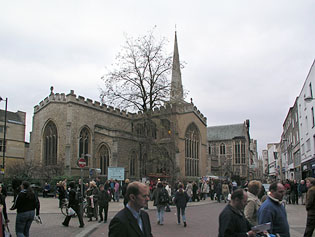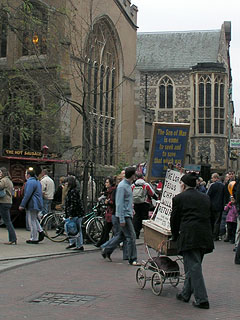 |
Holy Trinity is right in the middle of Cambridge's shopping area, hemmed in by Sidney Street and Market Street. Aside from Great St Mary's, it is probably the most recognisable of the city centre churches, with its spire rising above the rooftops and its little churchyard. It is an interesting exterior - big Perpendicular windows look out from ochre stucco and a bare stone chancel. Much of seems Victorian at first glance, but it's comely enough. In the summer, when dappled light falls through the false acacia trees, it can be quite pretty.
The junction between the two roads seems to be the venue of choice for street entertainers, vendors and evangelists, so the tall windows normally look down on some combination of Korean choristers, jewellery stalls, hungry-looking string quartets and purveyors of Sausage-inna-Bun. A little alleyway runs down the south side of the church to the back door of Marks and Sparks, and in the churchyard on that side there is a little octagonal shelter where old men congregate to grumble at each other and drink cider. Amidst all this activity, Holy Trinity can look very small.
 |
I was therefore rather surprised when I walked inside. Despite its compact site, Holy Trinity feels like a very big church. It is also rather a complicated space. The west tower sits entirely inside the body of the nave, with buttresses projecting to the east. This creates a narrow little passage along the west wall that leads to the vestry. The west wall is, incidentally, the oldest bit of the church, being from the original 12th century affair. The window and tower are 14th century, and the big buttresses are 15th century. Looking back at the tower arch from the nave, the effect is very complicated - the buttresses are decorated with cinquefoil panels, and the tower is also supported on the north and south by half-arches rather like flying buttresses built into the wall. A similar thing can be seen at *Little Wilbraham*, though it is much less elaborate there.
The main body of the nave is 14th century, but the same 15th century renovation that saw the building of the internal buttresses also gave us the great clerestory and transepts. The clerestory is remarkably large by comparison to the height of the 14th century arcades, and it continues round into the transepts. The roof is apparently original, and sits on rather nice corbels. The north window in the transept is a huge six-lighter. The south transept contains a gallery erected in the early 19th century - at this time, the perpetual curate was the Reverend Charles Simeon, a fellow of King's College. He used Holy Trinity as the centre of his Evangelical movement in Cambridge, and apparently preached to a packed church.
The Rev'd Simeon is long gone now - he died in 1836 and is remembered by an excessively elaborate Gothic wall-plate in the Victorian chancel. His evangelism must have seeped into the stones here, though - Holy Trinity is the local stronghold of the Alpha movement, and by far the most active of the central churches. The low-church atmosphere sits ill at ease in such a grand East Anglian Perpendicular space, but - as often seems to be the case with the Church of England - a reasonable compromise has been reached: Good News Bibles and grand stonework within, and an earnest dialogue with the sausage sellers without.
Holy Trinity is open intermittently.